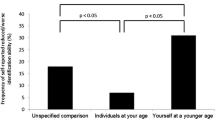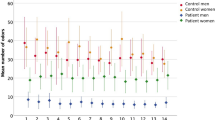Abstract
Introduction
Odor imagery is known to be more difficult than any other modality of sensory imagery. Consequently, wide between-individuals variability can be found in odor imagery ability. Several studies have shown a positive relationship between olfactory performance and odor imagery ability. In the light of factors known to influence smelling ability, this study therefore investigated the effects of two factors — gender and age — known to influence smelling ability, on self-declared odor imagery ability in normosmic individuals.
Methods
Seven hundred and nine French participants were asked to complete the web version of the French Vividness of Olfactory Imagery Questionnaire (fVOIQ). General linear models were used to determine the contributions of gender and age to odor imagery vividness scores. Moreover, scores were compared between age intervals ranging from 18–30 years old to 60 + years old.
Results
Our findings reveal that at any age, men and women have the same odor imagery ability. Odor imagery ability in self-declared normosmic individuals improves with age until 50–60 years old, and beyond this point the often-reported age-related olfactory decay does not alter it.
Conclusions
These findings suggest a high contribution of daily olfactory experience to the development of this cognitive function, and a relationship with olfactory performance that appears less linear than hypothesized.
Implications
This study provides food for thought in the field of olfaction: it suggests that distinct mechanisms may underlie two cognitive processes, perception and sensory imagery.


Similar content being viewed by others
Data availability
The dataset is accessible by following this https://doi.org/10.6084/m9.figshare.14974602
References
Albers MW, Tabert MH, Devanand DP (2006) Olfactory dysfunction as a predictor of neurodegenerative disease. Curr Neurol Neurosci Rep 6(5):379–386. https://doi.org/10.1007/s11910-996-0018-7
Arshamian A and Larsson M (2014) Same same but different: the case of olfactory imagery. Front Psychol 5(34). https://doi.org/10.3389/fpsyg.2014.00034
Arshamian A, Manko P, Majid A (2020) Limitations in odour simulation may originate from differential sensory embodiment. Biol Sci 375(1800):20190273. https://doi.org/10.1098/rstb.2019.0273
Arshamian A, Willander J, Larsson M (2011) Olfactory awareness is positively associated to odour memory. J Cogn Psychol 23(2):220–226. https://doi.org/10.1080/20445911.2011.483226
Ashton R, White KD (1980) Sex differences in imagery vividness : an artifact of the test. Br J Psychol 71(1):35–38. https://doi.org/10.1111/j.2044-8295.1980.tb02726.x
Bensafi M, Porter J, Pouliot S, Mainland J, Johnson B, Zelano C, Young N, Bremner E, Aframian D, Khan R, Sobel N (2003) Olfactomotor activity during imagery mimics that during perception. Nat Neurosci 6(11):1142–1144. https://doi.org/10.1038/nn1145
Bensafi M, Rouby C (2007) Individual differences in odor imaging ability reflect differences in olfactory and emotional perception. Chem Senses 32(3):237–244. https://doi.org/10.1093/chemse/bjl051
Betts GH (1910) The distribution and functions of mental imagery. Psychol Bull 7(10):351–352. https://doi.org/10.1037/h0064277
Brand G, Millot JL (2001) Sex differences in human olfaction: between evidence and enigma. Q J Exp Psychol Sec B 54(3b):259–270
Djordjevic J, Zatorre RJ, Petrides M, Boyle JA, Jones-Gotman M (2005) Functional neuroimaging of odor imagery. Neuroimage 24(3):791–801. https://doi.org/10.1016/j.neuroimage.2004.09.035
Doty RL and Kamath V (2014) The influences of age on olfaction: a review. Front Psychol 5(20). https://doi.org/10.3389/fpsyg.2014.00020
Engen T (1982) The perception of odors. Academic, New Year (1991) Odor sensation and memory
Fantin L, Ceyte H, Ramdane-Cherif Z, Jacquot M, Hossu G (2020) French vividness of olfactory imagery questionnaire : a potential tool for diagnosing olfactory loss by assessing olfactory imagery? Front Psychol 11:606667. https://doi.org/10.3389/fpsyg.2020.606667
Farah MJ, Levine DN, Calvanio R (1988) A case study of mental imagery deficit. Brain Cogn 8(2):147–164
Farah MJ, Soso MJ, Dasheiff RM (1992) Visual angle of the mind’s eye before and after unilateral occipital lobectomy. J Exp Psychol Hum Percept Perform 18(1):241
Ferdenzi C, Coureaud G, Camos V, Schaal B (2008) Human awareness and uses of odor cues in everyday life : results from a questionnaire study in children. Int J Behav Dev 32(5):422–431. https://doi.org/10.1177/0165025408093661
Fornazieri MA, Santos CAd, Bezerra TFP, Pinna FdR, Voegels RL, Doty RL (2015) Development of normative data for the Brazilian adaptation of the University of Pennsylvania Smell Identification Test. Chemical Senses 40(2):141–149. https://doi.org/10.1093/chemse/bju068
Gilbert AN, Crouch M, Kemp SE (1998) Olfactory and visual mental imagery. J Ment Imag 22:137–146
González J, Barros-Loscertales A, Pulvermüller F, Meseguer V, Sanjuán A, Belloch V, Ávila C (2006) Reading cinnamon activates olfactory brain regions. Neuroimage 32(2):906–912. https://doi.org/10.1016/j.neuroimage.2006.03.037
Guarneros M, Hudson R, López-Palacios M, Drucker-Colín R (2015) Reference values of olfactory function for Mexico City inhabitants. Arch Med Res 46(1):84–90. https://doi.org/10.1016/j.arcmed.2014.12.005
Haehner A, Hummel T, Reichmann H (2011) Olfactory loss in Parkinson’s disease. Parkinson’s Disease 2011:1–6. https://doi.org/10.4061/2011/450939
Havlicek J, Saxton TK, Roberts SC, Jozifkova E, Lhota S, Valentova J, Flegr J (2008) He sees, she smells? Male and female reports of sensory reliance in mate choice and non-mate choice contexts. Personality Individ Differ 45(6):565–570. https://doi.org/10.1016/j.paid.2008.06.019
Hedner M, Larsson M, Arnold N, Zucco GM, Hummel T (2010) Cognitive factors in odor detection, odor discrimination, and odor identification tasks. J Clin Exp Neuropsychol 32(10):1062–1067. https://doi.org/10.1080/13803391003683070
Hummel T, Kobal G, Gudziol H, Mackay-Sim A (2007) Normative data for the “Sniffin’ Sticks” including tests of odor identification, odor discrimination, and olfactory thresholds : an upgrade based on a group of more than 3,000 subjects. Eur Arch Otorhinolaryngol 264(3):237–243. https://doi.org/10.1007/s00405-006-0173-0
Hummel T, Smitka M, Puschmann S, Gerber JC, Schaal B, Buschhüter D (2011) Correlation between olfactory bulb volume and olfactory function in children and adolescents. Exp Brain Res 214(2):285–291. https://doi.org/10.1007/s00221-011-2832-7
Kern DW, Wroblewski KE, Schumm LP, Pinto JM, Chen RC, McClintock MK (2014) Olfactory function in wave 2 of the national social life, health, and aging project. J Gerontol B Psychol Sci Soc Sci 69(Suppl 2):S134–S143. https://doi.org/10.1093/geronb/gbu093
Kleemann AM, Kopietz R, Albrecht J, Schopf V, Pollatos O, Schreder T, May J, Linn J, Bruckmann H, Wiesmann M (2008) Investigation of breathing parameters during odor perception and olfactory imagery. Chem Senses 34(1):1–9. https://doi.org/10.1093/chemse/bjn042
Kobal G, Klimek L, Wolfensberger M, Gudziol H, Temmel A, Owen CM, Seeber H, Pauli E, Hummel T (2000) Multicenter investigation of 1,036 subjects using a standardized method for the assessment of olfactory function combining tests of odor identification, odor discrimination, and olfactory thresholds. Eur Arch Otorhinolaryngol 257(4):205–211. https://doi.org/10.1007/s004050050223
Kollndorfer K, Kowalczyk K, Nell S, Krajnik J, Mueller C A, and Schöpf V (2015) The inability to self-evaluate smell performance. How the vividness of mental images outweighs awareness of olfactory performance. Front Psychol 6(627). https://doi.org/10.3389/fpsyg.2015.00627
Larsson M, Hedner M, Olofsson J (2009) Differential age and sex effects in semantic recognition of odors and words. Acta Psychol Sin 41(11):1049–1053. https://doi.org/10.3724/SP.J.1041.2009.01049
Lawless HT (1997) Olfactory psychophysics. In Handbook of Perception and Cognition (Second Edition), Tasting and Smelling : 125-174. Academic Press. https://doi.org/10.1016/B978-012161958-9/50005-1
Lehrner JP (1999) Odor identification, consistency of label use, olfactory threshold and their relationships to odor memory over the human lifespan. Chem Senses 24(3):337–346. https://doi.org/10.1093/chemse/24.3.337
Mackay-Sim A, Johnston ANB, Owen C, Burne THJ (2006) Olfactory ability in the healthy population : reassessing presbyosmia. Chem Senses 31(8):763–771. https://doi.org/10.1093/chemse/bjl019
Majid A, Speed L, Croijmans I, Arshamian A (2017) What makes a better smeller? Perception 46(3–4):406–430. https://doi.org/10.1177/0301006616688224
Olsson P, Laska M (2010) Human male superiority in olfactory sensitivity to the sperm attractant odorant bourgeonal. Chem Senses 35(5):427–432. https://doi.org/10.1093/chemse/bjq030
Royet JP, Delon-Martin C, and Plailly J (2013) Odor mental imagery in non-experts in odors: a paradox? Front Hum Neurosci 7(87). https://doi.org/10.3389/fnhum.2013.00087
Sheehan PW (1967) A shortened form of Betts’ questionnaire upon mental imagery. J Clin Psychol 23:386–389. https://doi.org/10.1002/1097-4679(196707)23:3%3c386::aid-jclp2270230328%3e3.0.co;2-s
Sorokowska A, Drechsler E, Karwowski M and Hummel T (2017) Effects of olfactory training : a meta-analysis. Rhinology journal, 55(1). https://doi.org/10.4193/Rhino16.195
Sorokowska A, Schriever VA, Gudziol V, Hummel C, Hähner A, Iannilli E, Sinding C, Aziz M, Seo HS, Negoias S, Hummel T (2015) Changes of olfactory abilities in relation to age : odor identification in more than 1400 people aged 4 to 80 years. Eur Arch Otorhinolaryngol 272(8):1937–1944. https://doi.org/10.1007/s00405-014-3263-4
Sorokowski P, Karwowski M, Misiak M, Marczak MK, Dziekan M, Hummel T, Sorokowska A (2019) Sex differences in human olfaction : a meta-analysis. Front Psychol 10:242. https://doi.org/10.3389/fpsyg.2019.00242
Stevenson RJ, Boakes RA (2003) A mnemonic theory of odor perception. Psychol Rev 110(2):340–364. https://doi.org/10.1037/0033-295X.110.2.340
Stevenson RJ, Case TI (2005) Olfactory imagery : a review. Psychon Bull Rev 12(2):244–264. https://doi.org/10.3758/BF03196369
Stevenson RJ, Case TI, Mahmut M (2007) Difficulty in evoking odor images : the role of odor naming. Mem Cognit 35(3):578–589. https://doi.org/10.3758/BF03193296
Stevenson RJ, Mahmut M, Sundqvist N (2007) Age-related changes in odor discrimination. Dev Psychol 43(1):253–260. https://doi.org/10.1037/0012-1649.43.1.253
Tomiczek C, Stevenson RJ (2009) Olfactory imagery and repetition priming : the effect of odor naming and imagery ability. Exp Psychol 56(6):397–408. https://doi.org/10.1027/1618-3169.56.6.397
Wang J, Sun X and Yang QX (2016) Early aging effect on the function of the human central olfactory system. J Gerontol Ser A: Biomed Sci Med Sci 72(8):1007–1014. https://doi.org/10.1093/gerona/glw104
White KD, Ashton R, Law H (1978) The measurement of imagery vividness : effects of format and order on the Betts’ Questionnaire upon mental imagery. Can J Behav Sci 10(1):68–78. https://doi.org/10.1037/h0081537
Zatorre RJ, Halpern AR (1993) Effect of unilateral temporal-lobe excision on perception and imagery of songs. Neuropsychologia 31(3):221–232
Zelano C, Mohanty A, Gottfried JA (2011) Olfactory predictive codes and stimulus templates in piriform cortex. Neuron 72(1):178–187. https://doi.org/10.1016/j.neuron.2011.08.010
Zucco GM, Hummel T, Tomaiuolo F, Stevenson RJ (2014) The influence of short-term memory on standard discrimination and cued identification olfactory tasks. J Neurosci Methods 222:138–141. https://doi.org/10.1016/j.jneumeth.2013.11.006
Author information
Authors and Affiliations
Contributions
Conceptualization: GH and HC; Methodology: GH and HC; Formal analysis and investigation: LF, CP, GH and HC; Writing – original draft: LF, GH and HC; Writing – review and editing: CP and CR; Project administration: GH and HC; Visualization: LF, GH and HC.
Corresponding author
Ethics declarations
Conflict of Interest
The authors have no relevant financial of non-financial interests to disclose.
Ethical Approval
Participants in this study were not asked to provide any identifying data. Therefore, in accordance with local legislation, no ethical approval was needed to conduct this study.
Informed Consent
Participants provided their consent to participate in this study by voluntarily completing the online form.
Additional information
Publisher's Note
Springer Nature remains neutral with regard to jurisdictional claims in published maps and institutional affiliations.
Rights and permissions
Springer Nature or its licensor (e.g. a society or other partner) holds exclusive rights to this article under a publishing agreement with the author(s) or other rightsholder(s); author self-archiving of the accepted manuscript version of this article is solely governed by the terms of such publishing agreement and applicable law.
About this article
Cite this article
Fantin, L., Pinzano, C., Rumeau, C. et al. Effects of Gender and Age on Self-reported Odor Imagery Ability. Chem. Percept. 15, 145–153 (2022). https://doi.org/10.1007/s12078-022-09302-0
Received:
Accepted:
Published:
Issue Date:
DOI: https://doi.org/10.1007/s12078-022-09302-0




